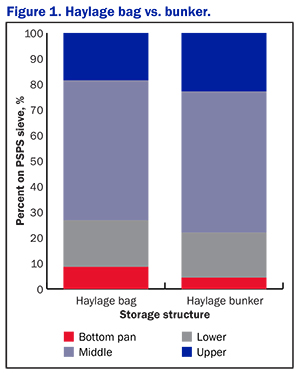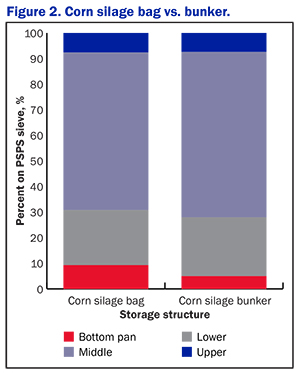
Forage particle size influenced by storage method? Absolutely! – Margaret Quaassdorff, Vita Plus

To our knowledge, we know of no effort to quantify the difference in particle size and distribution between forages coming out of bags versus bunkers or piles. To check our theory, we collected forage samples from more than 65 bags, bunkers and piles, and analyzed them using a Penn State Particle Separator to develop a preliminary database.
However, bagged haylage had 4.2 percent more particles in the bottom pan versus haylage from bunkers or piles. This means, not only does bagged haylage differ in particle distribution versus bunkers or piles, but it is also more processed and contains more short and fine particles than a bunker or pile.
Looking at Figure 2, we see corn silage in both bags and bunkers or piles yielded similar percentages of particles greater than 0.75 inches. We also see a smaller percentage of particles on the middle and lower sieves from corn silage coming out of bags versus bunkers or piles, which is accounted for by a larger percentage in the bottom pan with particles less than 0.07 inches (9.3 percent in bags versus 5.0 percent in bunkers or piles). Again, we can conclude the particle distribution from corn silage coming out of bags is different than bunkers or piles, and storing corn silage in bags yields a more highly processed product.


On average, corn silage out of bags and bunkers or piles fell within the ranges for the top and middle sieves, though at the respective upper limits for each, but fell short of recommendations on the lower sieve. Corn silage out of a bag exceeded the recommendation of 5.0 percent on the bottom pan, while corn silage out of a bunker or pile was at the high end of the recommended range for the bottom pan.

We will discuss the implications of these structural particle size differences in the next edition of Forage Foundations.
| Category: |
Facility design Feed quality and nutrition Forage Foundations Forage storage and management |

